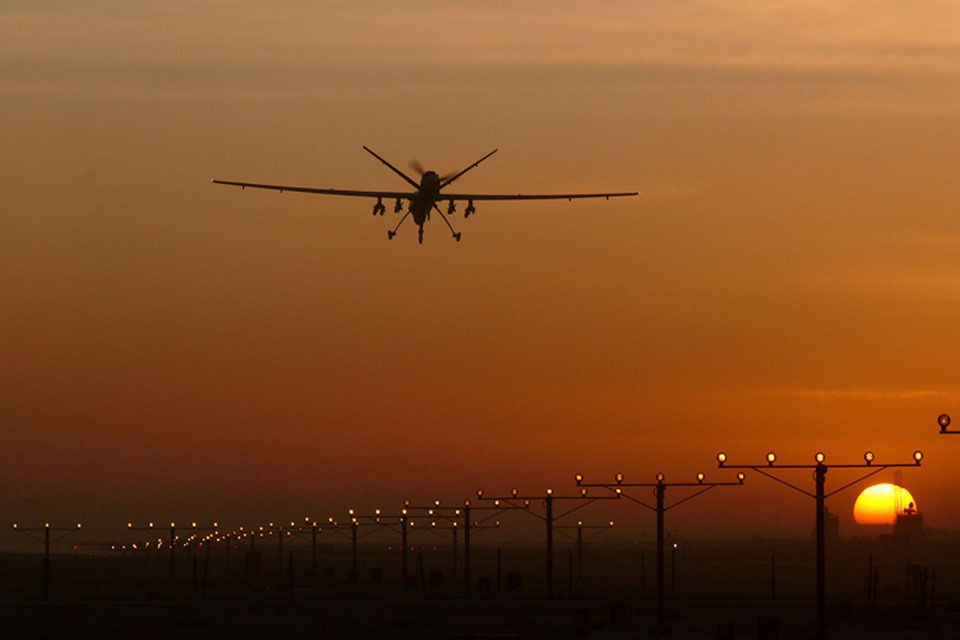RAF Reaper team uncovers Afghan drugs haul
An RAF team has uncovered a huge stash of drugs in a truck in Afghanistan using a Remotely Piloted Air System (RPAS).

Targeting camera stills taken from the RAF Reaper mission showing the vehicles being used to transport the seized haul of weapons and drugs [Picture: Crown Copyright/MOD 2012]
Members of 39 Squadron (39 Sqn) were supporting the Afghan National Security Forces (ANSF) and the United States Marine Corps (USMC) in identifying drug traffickers transiting through southern Helmand.
During the mission, 39 Sqn were directed to a suspect vehicle which later met up with a pick-up truck. 39 Sqn used their Reaper RPAS to observe from above that the flatbed section of the truck was too shallow for a normal vehicle and as a result probably contained a hidden compartment.
Using the Reaper, the team from 39 Sqn tracked both vehicles, enabling ANSF and USMC personnel to intercept them safely.
As a direct result of the work the RAF team did, 1,280kg of dry opium and 59kg of refined heroin was found hidden within the vehicles. Four weapons were also confiscated and the drug traffickers involved were detained.
The US street price for the heroin alone was estimated at $14,750,000, and 39 Sqn were involved in the interdiction of a further two vehicles where 860kg of dry opium was discovered. The narcotics were destroyed on site.
So far, this narcotics operation has denied criminal gangs approximately $10m (at local Afghan prices) in funding.
Officer Commanding 39 Sqn, Wing Commander Andy Bird, said:
The pick-up truck looked heavy and the flatbed at the rear seemed too shallow, so it aroused our suspicions. This is exactly the sort of indicator that our personnel are trained to identify.
We were able to work closely with coalition troops who seized weapons and a large haul of opium and heroin worth millions of dollars. We were delighted, as this sort of success deprives the Taliban of resources and it helps keep drugs off the streets of the UK too.
It was a very good spot indeed and I was very proud of the whole team. We are contributing directly to bringing stability to Afghanistan as we prepare to hand over responsibility to the Afghan security forces.
The Reaper is a medium-to-high-altitude, long-endurance RPAS and its primary mission is as an intelligence, surveillance, target acquisition and reconnaissance asset. Its sensors provide real-time data to commanders and intelligence specialists at all levels.
Its secondary mission is to attack targets in the battlespace and also to provide close air support options to the unit being supported by the Reaper and its remote crew.

An RAF Reaper comes in to land (library image) [Picture: Flying Officer Owen Cheverton, Crown Copyright/MOD 2011]
Wg Cdr Bird added:
The Reaper is a really flexible system - we can be airborne for up to 20 hours, building up a detailed picture of what is happening on the ground. If needed, we have sophisticated weapons which can be precisely targeted.
One of our main jobs is spotting insurgents who might be targeting troops on the ground with improvised explosive devices. We are their ‘eyes in the sky’ - we do everything we can to enable coalition troops to conduct their important missions as safely as possible.
Although we are remote from the battlefield, there is always a team of RAF personnel involved in flying every mission. We take real pride in our mission, which is to support troops on the ground.
The RAF team operates the Reaper remotely from Creech Air Force Base in the United States.